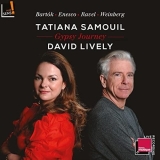Die russische Geigerin Tatiana Samouil und der amerikanisch-französische Pianist David Lively setzen ihre erfolgreiche Zusammenarbeit bei Indésens fort mit einem attraktiven Programm, das mit einer ungemein stimmungsvollen Interpretation des Impromptu Concertant von Enescu beginnt. Von diesem Komponisten ist auch die 1926 entstandene dritte Sonate « dans le caractère populaire roumain » (im rumänischen Volksstil) zu hören. Auch sie spielen Samouil und Lively sehr lebhaft, inspiriert und gefühlvoll, weitaus faszinierender und berührender als der Komponist selber in seiner Aufnahme mit Dinu Lipatti.
Mit ebenso viel Gestaltungsphantasie führen sie Weinbergs Rhapsodie und Bartoks Rumänische Volkstänze auf. Samouil verleiht den Volkstänzen einen vollblütigen Klang, der durch seine oft koketten, unregelmäßigen Tempi sehr evokativ wird.
In der Tzigane erreicht Tatiana Samouil bei einem exquisit kultivierten und raffinierten Spiel eine große Ausdruckskraft, die im zweiten Teil des Stücks im Zusammenspiel mit dem kongenial mitgestaltenden Pianisten David Lively noch spannender wirkt. Eine ausgeprägte Klangfarbenphantasie produziert kontrastreiche Stimmungen, die den Hörer auch ohne jede Aggressivität ins instrumentale Geschehen einbinden.
Russian violinist Tatiana Samouil and American-French pianist David Lively continue their successful collaboration on Indésens with an attractive program that begins with an atmospheric interpretation of Enescu’s Impromptu Concertant. From the same composer they perform the Third Sonata « dans le caractère populaire roumain » (in Romanian folk style). It is played in a very lively, inspired and soulful manner, far more fascinating and touching than the composer’s own recording with Dinu Lipatti.
Samouil and Lively perform Weinberg’s Rhapsody and Bartok’s Romanian Folk Dances with just as much imagination. Samouil gives the folk dances a full-blooded sound, made highly evocative by the flirtatious irregular tempos.
In the Tzigane, Tatiana Samouil achieves great expressiveness with exquisitely cultivated and refined playing, which becomes even more exciting in the second part of the piece in the interplay with the congenially collaborating pianist David Lively. A distinct fantasy of tone color produces contrasting moods that involve the listener in the instrumental action without any aggressiveness.






















